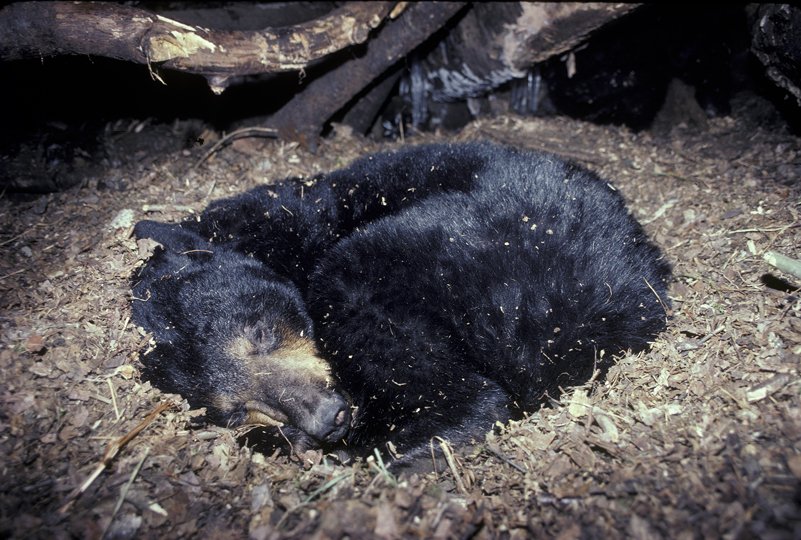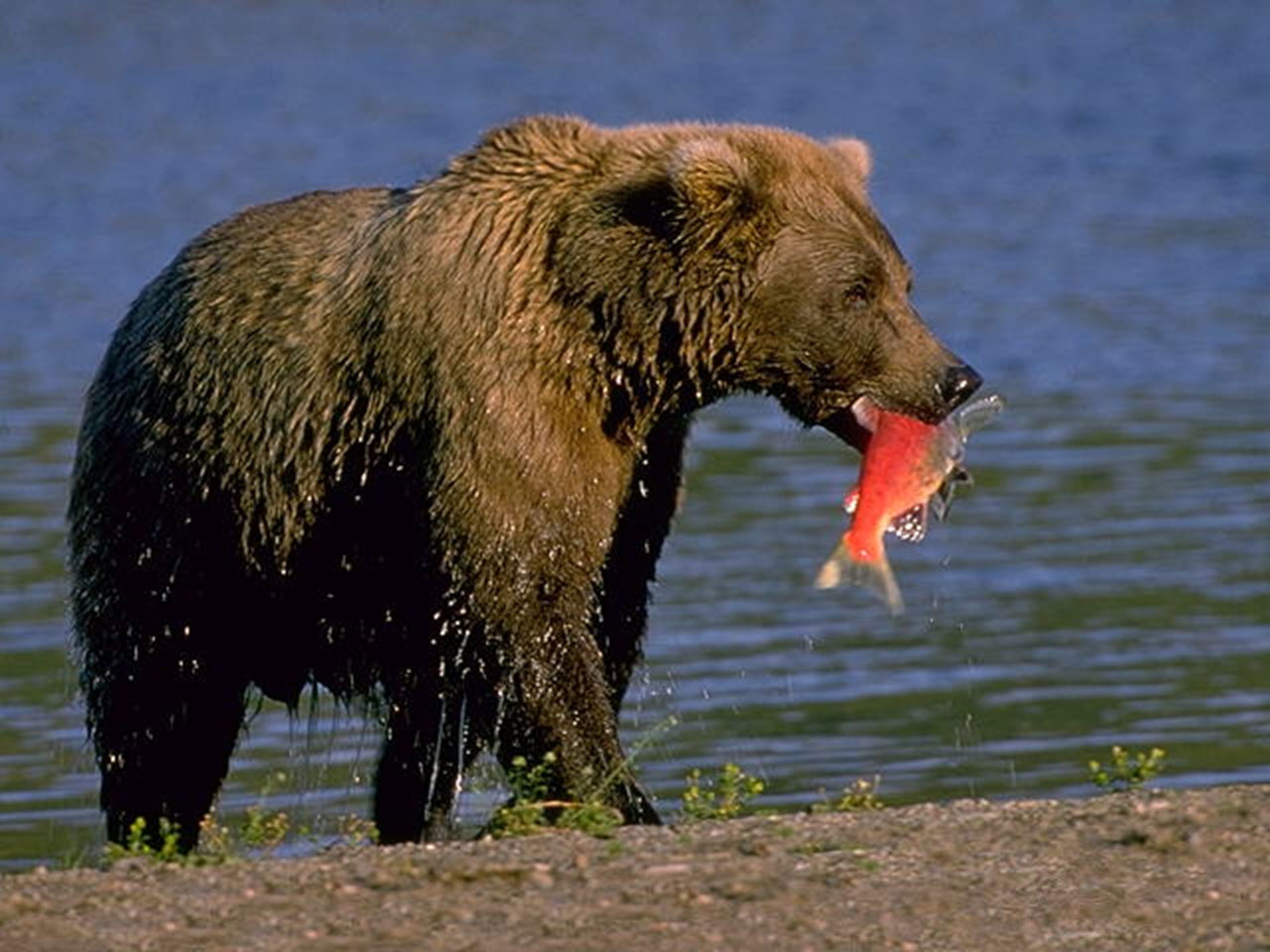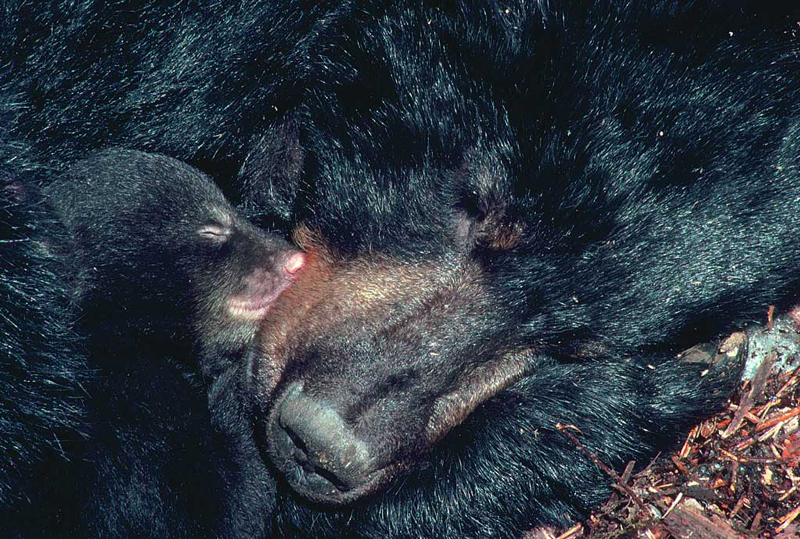What happens to the bear during hibernation? Expert commentary

Every autumn, bears of temperate and polar latitudes (in particular, brown and black) begin to prepare for hibernation. All spring, summer and autumn, these animals were actively feeding, feeding fat reserves for the winter. And now, when the cold comes, they are looking for a suitable shelter to spend the winter. After the shelter is found, the bear hibernates.
Hibernating bears in some cases lasts up to six months. During hibernation, some species, such as the black bear (Ursus americanus), reduce the pulse from 55 beats per minute to about 9. The metabolic rate is reduced by 53%. Naturally, all this time bears do not eat, do not drink and do not produce waste. How do they do it?
To understand what is happening in the body of a bear during hibernation, it is necessary to immediately clarify what hibernation itself is. And why is it not "anabiosis" in the literal sense of the word. In the literal sense of the term, “anabiosis” is a process of complete inactivity of an animal. At this time, the level of metabolism is reduced to indicators that for most higher animals are incompatible with life.
')
Some amphibian species (some tritons and frogs) freeze in cold weather, thawing without harm for themselves when the warm season comes. Painless this “freezing” literally through them is in connection with the development of a specific substance that has antifreeze properties that prevent water from freezing in their body.
Bears do not freeze. Their body temperature during hibernation remains high enough, which allows them to wake up in case of any danger, coming out of the den. By the way, bears that have woken up ahead of time are called “rods”. They represent a significant danger to humans, because in winter a bear cannot find enough food, and is always hungry and aggressive.
Some researchers argue that bears do not fall into anabiosis, as mentioned above. But there are also scientists who call bears “super-anabiosis” because they don’t eat, drink or defecate for half a year, while remaining able to quickly get out of hibernation - this is a unique phenomenon in the animal world.
“In my opinion, bears are the best anabiosis in the world,” says Brian Barnes of the University of Alaska's Arctic Biology Institute (Fairbanks). This scientist spent three years studying the characteristics of hibernation of black bears.
“Their body is a closed system. They can spend the whole winter using only oxygen for breathing - that’s all they need, ”says Barnes.
Why bears do not defecate during hibernation? In short, it is because a fecal plug forms in their bodies at this time. This is a special mass, which researchers have long found in the esophagus of bears that have hibernated.
Previously, it was believed that bears, before getting into the den, eat large amounts of plant material, wool of other bears and other materials that are not digested, and which then form a plug in the intestines of the animal. Scientists who came to this conclusion relied heavily on information from bear hunters. They argued that the method of feeding mentioned above led to a “fastening of the intestines” and the animal simply could not perform an act of defecation during sleep.
In fact, it is not. Bears do not eat anything special before hibernation. They, as omnivores, try to consume any food available to them, including fruits, vegetables, nuts, meat, fish, berries, and more.

And during hibernation the intestine of the animal continues to work. Not in the mode of the previous activity, but still it works. Cells continue to divide, intestinal secretion is carried out. All this forms a small amount of feces, which accumulate in the intestines of the animal. Formed "tube" with a diameter of 3.8 to 6.4 centimeters.
“Fecal stoppers are the same waste products that have been in the intestines of an animal for so long that the walls of the intestines absorb liquids from this mass, leaving it dry and hard,” says the website of the North American Center for the Study of Bears. Thus, the bear's body does not lose the water it needs, the reserves of which in the den are almost impossible to replenish.
Experts placed cameras in bears' dens, which recorded everything that happened during hibernation. As it turned out, plant fibers and wool are often part of the cork because a bear, even during hibernation, can pick up something from the ground in a den, and maybe even lick its wool.

After the bear comes out of the den, they clean the intestines, which begins to function normally. Usually defecation occurs already on the threshold of the den. Therefore, there are no mystics or riddles, as some hunters or even scientists say, in a bear traffic jam. All of this - the product of the body. By the way, a bear in a den does not suck a paw at all. The fact is that in January and February there is a change in the skin on the pads. Old skin bursts, itches, which causes the bear a known inconvenience. In order to relieve the itch, the bear licks its paws.
In order to clarify the details of the process of hibernation in bears, I asked for a comment from scientists from Krivoy Rog State Pedagogical University.
How do bears keep their bodies hibernating?
Each animal exists due to the metabolism and energy that is provided by the food consumed. Naturally, the more active the lifestyle and the more intense the physiological processes, the more “fuel” in the form of food must be introduced into the body. In the organism, which is at rest in the form of hibernation, the intensity of all metabolic processes is reduced to a physiological minimum. That is, energy is expended exactly as much as it is necessary in order for the beast to remain alive and so that degenerative processes in the tissues and organs do not occur due to the lack of energy. In general, this state can be compared with what happens during normal sleep, but, naturally, it is more “exaggerated”.
The main consumer of energy in the body are the brain and muscles (at least 2/3 of the total energy of the body). But since the muscular system during sleep is inactive, its cells receive as much energy as is necessary to maintain their existence. Therefore, the rest of the organs, which also receive very little energy, begin to work at “low revs”. The digestive system is essentially nothing to digest (since the intestines are almost empty, as mentioned above). Where, then, does this minimum amount of energy come from, which is still necessary for the beast? It is extracted from the reserves of fat and glycogen accumulated during the active period of the year. They are spent gradually and usually they are enough until the spring.
By the way, the bears quite often become precisely those bears that “ate badly” in the summer. There are many oral stories that the rods in the hungry years more. So, the reserves of fat and glycogen - the main source of energy. Another vital substance is oxygen. But since the organism is inactive, much less oxygen is needed. Thus, the respiratory rate is significantly reduced. And if the tissues of the body during hibernation require a very small amount of oxygen and nutrients, then the blood that carries them, you can move much slower. Therefore, the frequency of contractions of the heart is significantly reduced, and accordingly, the heart also consumes less energy. Not only blocking of the intestines, but also the actual suspension of kidney activity is associated with water saving.
Are there other examples of hibernation among warm-blooded animals?
Such a device as hibernation in bears is quite unusual for warm-blooded phenomena, but not at all unique. It is also found in hedgehogs of temperate latitudes, inhabitants of the Eurasian steppes of marmots, some members of the family Kunih (badger). Proteins and raccoon dogs can fall into a similar state of cold and hungry winters, but not for long, and their vital processes do not slow down as bears have. In addition to hibernation (hibernation), there is also summer hibernation (estivation). Some inhabitants of the hot deserts (some insectivores, rodents, marsupials) fall into the latter.
This happens in the hottest periods of the year, when the extraction of feed and water becomes much more energy-intensive and, in fact, inefficient. Therefore, it is easier for the animal to hibernate and wait out adverse conditions. In addition to seasonal hibernation, it is also daily. It is characteristic of some flying warm-blooded animals - hummingbirds and bats. The fact is that both of them and others flap their wings very quickly during the flight. Due to this, their flight has become more maneuverable, and the extraction of feed more efficient. But for everything in nature you have to pay. Their flying muscles consume a lot of energy, which is not enough for a full day (despite the fact that both hummingbirds and bats consume food weighing more than half of their own weight during the active phase of the day).
As you can see, their metabolic rate is simply enormous. Therefore, during sleep (and rest in the form of sleep is necessary for each animal - this is also a normal and indispensable physiological process), their vital activity is reduced to parameters comparable to those observed in bears.
What is the difference between the state of hibernation of bears from, for example, anabiosis of frogs?
Warm-blooded physiological processes during hibernation cannot be completely “turned off”. On that they and warm-blooded - it is necessary independently heat produced. Another picture can be observed in poikilothermic animals - their vital processes are almost completely suspended. That is, the cells of the body remain practically in a preserved state until better times - when the sun warms and gives enough heat to warm the body. This happens in all temperate amphibians and more northern latitudes.
It is a known fact that individuals of the tail amphibian of the Siberian abduction after being literally frozen into the ice for several decades (!) “Came to life” after thawing and felt quite normal. Also hibernating snakes and lizards fall into anabiosis, but their bodies are not so tenacious (they will not suffer frost damage). Another example is fish living in drying up waters of Africa, South America and Australia, and burrowing in silt for a period of drought. The processes occurring in their body during this period are close to those that occur in amphibians - almost complete suspension of life until better times.
As for reptiles from hot countries, it should be said that, although they are cold-blooded, the experience of adverse conditions is more similar to that of warm-blooded ones - a significant decrease in the intensity of physiological processes, but not a halt (there is enough solar thermal energy). Large reptiles (crocodiles, pythons and boas) thus “rest” for up to a year, digesting the eaten large prey.
Is it possible to artificially create a hibernation mode for animals that do not hibernate?
Not. It will be an abnormal condition like a coma.
How could a similar wintering mechanism appear in bears? Has such a mechanism been developed for many hundreds of thousands of years or has it appeared spontaneously?
All physiological processes are genetically controlled. In the course of evolution, a certain group of individuals could have a certain physiological peculiarity consisting in a special sleep mode (daily, normal) in the cold period of the year, accompanied by a slight decrease in physiological activity and a drop in body temperature by 1-2 degrees.
This feature gave these individuals a certain advantage in terms of more economical energy consumption in conditions with less feed. However, she began to give such a great advantage in survival that gradually only such mutants remained in the population. Subsequently, the selection by this feature continued - sleep became more and more long and deep, and the intensity of the body's processes decreased more and more. Finally, the animals learned to make their dens. By the way, this feature could give a significant advantage also because just during hibernation the female gives birth to babies and they are at this time warm and protected, hidden from prying eyes. In general, the evolution of the hibernation phenomenon has continued (and perhaps continues) for, of course, no less than a few hundred thousand years.
For assistance in preparing the article, the editorial office of Geektimes thanks:
Broshko Evgenia Olegovich, PhD, Senior Lecturer, Department of Zoology, KSPU (Krivoy Rog State Pedagogical University)
Evtushenko Eduard Alekseevich, Ph.D., Associate Professor, Department of Botany and Ecology, KSPU
Source: https://habr.com/ru/post/369759/
All Articles